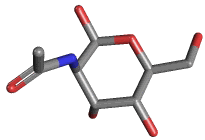|
N-ACETYL-D-MANNOSAMINE |
| Synonyms. N-Acetyl-D-mannosamine; N-Acetyl-beta-D-mannosamine; 2-(Acetylamino)-2-deoxy-beta-D-mannopyranose; N-(2,4,5-Trihydroxy-6-(hydroxymethyl)oxan-3-yl)acetamide; 2-Acetamido-2-deoxy-alpha-D-glucopyranose; |
|
|
| PRODUCT IDENTIFICATION | |
|
CAS RN |
7772-94-3 |
|
EINECS RN |
|
|
FORMULA |
C8H15NO6 |
|
MOLE WEIGHT |
221.21 |
|
H.S CODE |
2940.00.6000 |
|
SMILES |
O.CC(=O)N[C@@H]1[C@@H](O)O[C@@H](CO)[C@@H](O)[C@@H]1O |
|
CLASSIFICATION |
Carbohydrate |
|
EXTRA NOTES |
Biochem/physiol Actions:N-Acetyl-D-mannosamine (ManNAc) is an essential precursor of N-acetylneuraminic acid (NeuAc), the specific monomer of polysialic acid. Transport studies in the E. coli K1 strain have been performed to probe the effect of ManNAc on capsular polysialic acid production. (sigmaaldrich) |
|
|
| PHYSICAL AND CHEMICAL PROPERTIES | |
|
PHYSICAL STATE. |
white to pale yellow crystalline powder |
|
MELTING POINT |
129 ~ 132 C |
|
BOILING POINT |
|
|
DENSITY |
|
|
SOLUBILITY IN WATER |
|
| SOLVENT SOLUBILITY |
|
|
VAPOR DENSITY |
|
|
log P(octanol-water) |
|
|
VAPOR PRESSURE |
|
|
AUTOIGNITION TEMP |
|
| pK |
|
|
REFRACTIVE INDEX |
|
|
FLASH POINT |
|
|
|
| STABILITY AND REACTIVITY | |
| STABILITY | Stable under normal conditions. |
|
INCOMPATIBLE MATERIALS |
Strong oxidizing agents |
| POLYMERIZATION |
Has not been reported |
|
NFPA RATINGS |
Health: 0, Flammability: 0, Reactivity: 0 |
|
|
| EXTERNAL LINKS & GENERAL DESCRIPTION |
|
USA.gov - N-Acetyl-D-mannosamine Wikipedia Linking - Mannosamine Google Scholar Search - N-Acetyl-D-mannosamine U.S. National Library of Medicine - N-Acetylmannosamine PubChem Compound Summary - N-Acetylmannosamine KEGG (Kyoto Encyclopedia of Genes and Genomes) - N-Acetyl-D-mannosamine http://www.ebi.ac.uk/chebi/ - N-Acetylmannosamine http://www.ncbi.nlm.nih.gov/ - N-Acetyl-D-mannosamine EPA - Substance Registry Services - N-Acetyl-D-mannosamine |
|
|
| SALES SPECIFICATION | |
|
APPEARANCE |
white to pale yellow crystalline powder |
|
ASSAY |
98% min |
|
MELTING POINT |
128 ~ 132 C |
| OPTICAL ROTATION |
+9.5° ~ +10.5° (c=4, water) |
|
LOSS ON DRYING |
1% max |
|
HEAVY METALS |
10ppm max |
|
|
| TRANSPORT & REGULATORY INFORMATION | |
|
UN NO. |
|
| HAZARD CLASS |
|
| PACKING GROUP | |
|
|
| SAFETY INFORMATION | |
|
HAZARD OVERVIEW |
GHS (Globally Harmonised System) Classification: Not a dangerous substance. Potential Health Effects: Eyes - May cause eye irritation. Skin - May be harmful if absorbed through skin May cause skin irritation. Inhalation - May be harmful if inhaled. May cause respiratory tract irritation. Ingestion - May be harmful if swallowed. |
| HAZARD CODES |
|
|
RISK PHRASES |
|
|
SAFETY PHRASES |
|
|
|
| PACKING |
|
Preserved in light-resistant and well-closed bottles |
|
|
